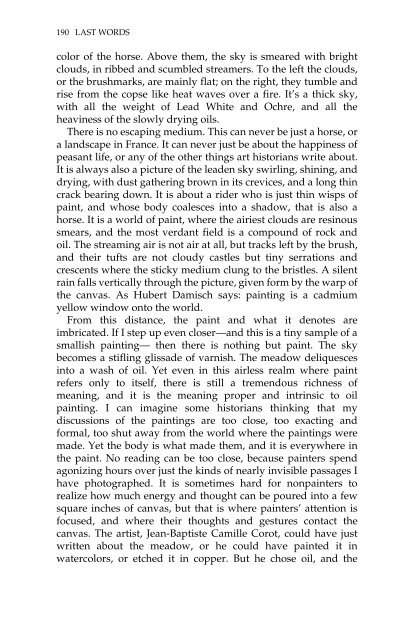What Painting Is: How to Think about Oil Painting ... - Victoria Vesna
What Painting Is: How to Think about Oil Painting ... - Victoria Vesna
What Painting Is: How to Think about Oil Painting ... - Victoria Vesna
Create successful ePaper yourself
Turn your PDF publications into a flip-book with our unique Google optimized e-Paper software.
190 LAST WORDS<br />
color of the horse. Above them, the sky is smeared with bright<br />
clouds, in ribbed and scumbled streamers. To the left the clouds,<br />
or the brushmarks, are mainly flat; on the right, they tumble and<br />
rise from the copse like heat waves over a fire. It’s a thick sky,<br />
with all the weight of Lead White and Ochre, and all the<br />
heaviness of the slowly drying oils.<br />
There is no escaping medium. This can never be just a horse, or<br />
a landscape in France. It can never just be <strong>about</strong> the happiness of<br />
peasant life, or any of the other things art his<strong>to</strong>rians write <strong>about</strong>.<br />
It is always also a picture of the leaden sky swirling, shining, and<br />
drying, with dust gathering brown in its crevices, and a long thin<br />
crack bearing down. It is <strong>about</strong> a rider who is just thin wisps of<br />
paint, and whose body coalesces in<strong>to</strong> a shadow, that is also a<br />
horse. It is a world of paint, where the airiest clouds are resinous<br />
smears, and the most verdant field is a compound of rock and<br />
oil. The streaming air is not air at all, but tracks left by the brush,<br />
and their tufts are not cloudy castles but tiny serrations and<br />
crescents where the sticky medium clung <strong>to</strong> the bristles. A silent<br />
rain falls vertically through the picture, given form by the warp of<br />
the canvas. As Hubert Damisch says: painting is a cadmium<br />
yellow window on<strong>to</strong> the world.<br />
From this distance, the paint and what it denotes are<br />
imbricated. If I step up even closer—and this is a tiny sample of a<br />
smallish painting— then there is nothing but paint. The sky<br />
becomes a stifling glissade of varnish. The meadow deliquesces<br />
in<strong>to</strong> a wash of oil. Yet even in this airless realm where paint<br />
refers only <strong>to</strong> itself, there is still a tremendous richness of<br />
meaning, and it is the meaning proper and intrinsic <strong>to</strong> oil<br />
painting. I can imagine some his<strong>to</strong>rians thinking that my<br />
discussions of the paintings are <strong>to</strong>o close, <strong>to</strong>o exacting and<br />
formal, <strong>to</strong>o shut away from the world where the paintings were<br />
made. Yet the body is what made them, and it is everywhere in<br />
the paint. No reading can be <strong>to</strong>o close, because painters spend<br />
agonizing hours over just the kinds of nearly invisible passages I<br />
have pho<strong>to</strong>graphed. It is sometimes hard for nonpainters <strong>to</strong><br />
realize how much energy and thought can be poured in<strong>to</strong> a few<br />
square inches of canvas, but that is where painters’ attention is<br />
focused, and where their thoughts and gestures contact the<br />
canvas. The artist, Jean-Baptiste Camille Corot, could have just<br />
written <strong>about</strong> the meadow, or he could have painted it in<br />
watercolors, or etched it in copper. But he chose oil, and the


